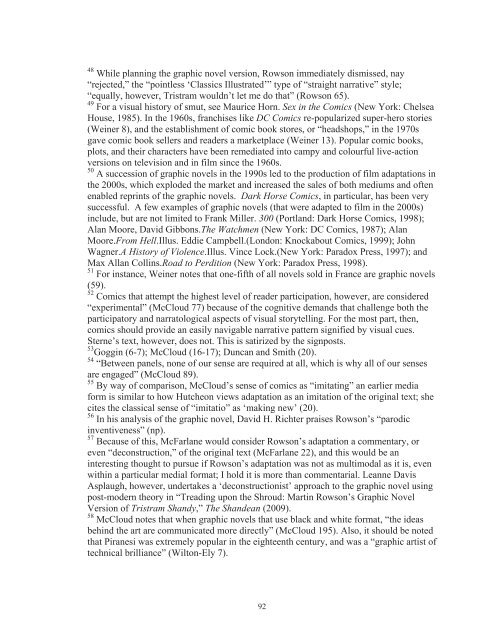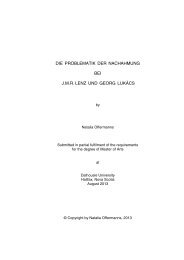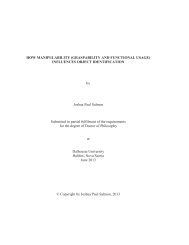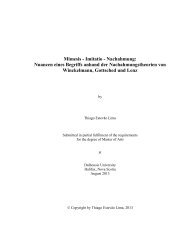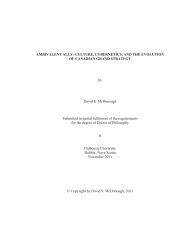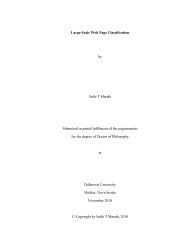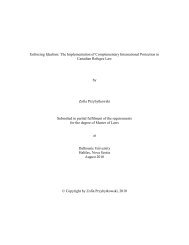ADAPTING TRISTRAM SHANDY by Adria Young Submitted in ...
ADAPTING TRISTRAM SHANDY by Adria Young Submitted in ...
ADAPTING TRISTRAM SHANDY by Adria Young Submitted in ...
You also want an ePaper? Increase the reach of your titles
YUMPU automatically turns print PDFs into web optimized ePapers that Google loves.
48<br />
While plann<strong>in</strong>g the graphic novel version, Rowson immediately dismissed, nay<br />
“rejected,” the “po<strong>in</strong>tless ‘Classics Illustrated’” type of “straight narrative” style;<br />
“equally, however, Tristram wouldn’t let me do that” (Rowson 65).<br />
49<br />
For a visual history of smut, see Maurice Horn. Sex <strong>in</strong> the Comics (New York: Chelsea<br />
House, 1985). In the 1960s, franchises like DC Comics re-popularized super-hero stories<br />
(We<strong>in</strong>er 8), and the establishment of comic book stores, or “headshops,” <strong>in</strong> the 1970s<br />
gave comic book sellers and readers a marketplace (We<strong>in</strong>er 13). Popular comic books,<br />
plots, and their characters have been remediated <strong>in</strong>to campy and colourful live-action<br />
versions on television and <strong>in</strong> film s<strong>in</strong>ce the 1960s.<br />
50<br />
A succession of graphic novels <strong>in</strong> the 1990s led to the production of film adaptations <strong>in</strong><br />
the 2000s, which exploded the market and <strong>in</strong>creased the sales of both mediums and often<br />
enabled repr<strong>in</strong>ts of the graphic novels. Dark Horse Comics, <strong>in</strong> particular, has been very<br />
successful. A few examples of graphic novels (that were adapted to film <strong>in</strong> the 2000s)<br />
<strong>in</strong>clude, but are not limited to Frank Miller. 300 (Portland: Dark Horse Comics, 1998);<br />
Alan Moore, David Gibbons.The Watchmen (New York: DC Comics, 1987); Alan<br />
Moore.From Hell.Illus. Eddie Campbell.(London: Knockabout Comics, 1999); John<br />
Wagner.A History of Violence.Illus. V<strong>in</strong>ce Lock.(New York: Paradox Press, 1997); and<br />
Max Allan Coll<strong>in</strong>s.Road to Perdition (New York: Paradox Press, 1998).<br />
51<br />
For <strong>in</strong>stance, We<strong>in</strong>er notes that one-fifth of all novels sold <strong>in</strong> France are graphic novels<br />
(59).<br />
52<br />
Comics that attempt the highest level of reader participation, however, are considered<br />
“experimental” (McCloud 77) because of the cognitive demands that challenge both the<br />
participatory and narratological aspects of visual storytell<strong>in</strong>g. For the most part, then,<br />
comics should provide an easily navigable narrative pattern signified <strong>by</strong> visual cues.<br />
Sterne’s text, however, does not. This is satirized <strong>by</strong> the signposts.<br />
53<br />
Gogg<strong>in</strong> (6-7); McCloud (16-17); Duncan and Smith (20).<br />
54<br />
“Between panels, none of our sense are required at all, which is why all of our senses<br />
are engaged” (McCloud 89).<br />
55<br />
By way of comparison, McCloud’s sense of comics as “imitat<strong>in</strong>g” an earlier media<br />
form is similar to how Hutcheon views adaptation as an imitation of the orig<strong>in</strong>al text; she<br />
cites the classical sense of “imitatio” as ‘mak<strong>in</strong>g new’ (20).<br />
56<br />
In his analysis of the graphic novel, David H. Richter praises Rowson’s “parodic<br />
<strong>in</strong>ventiveness” (np).<br />
57<br />
Because of this, McFarlane would consider Rowson’s adaptation a commentary, or<br />
even “deconstruction,” of the orig<strong>in</strong>al text (McFarlane 22), and this would be an<br />
<strong>in</strong>terest<strong>in</strong>g thought to pursue if Rowson’s adaptation was not as multimodal as it is, even<br />
with<strong>in</strong> a particular medial format; I hold it is more than commentarial. Leanne Davis<br />
Asplaugh, however, undertakes a ‘deconstructionist’ approach to the graphic novel us<strong>in</strong>g<br />
post-modern theory <strong>in</strong> “Tread<strong>in</strong>g upon the Shroud: Mart<strong>in</strong> Rowson’s Graphic Novel<br />
Version of Tristram Shandy,” The Shandean (2009).<br />
58<br />
McCloud notes that when graphic novels that use black and white format, “the ideas<br />
beh<strong>in</strong>d the art are communicated more directly” (McCloud 195). Also, it should be noted<br />
that Piranesi was extremely popular <strong>in</strong> the eighteenth century, and was a “graphic artist of<br />
technical brilliance” (Wilton-Ely 7).<br />
92


